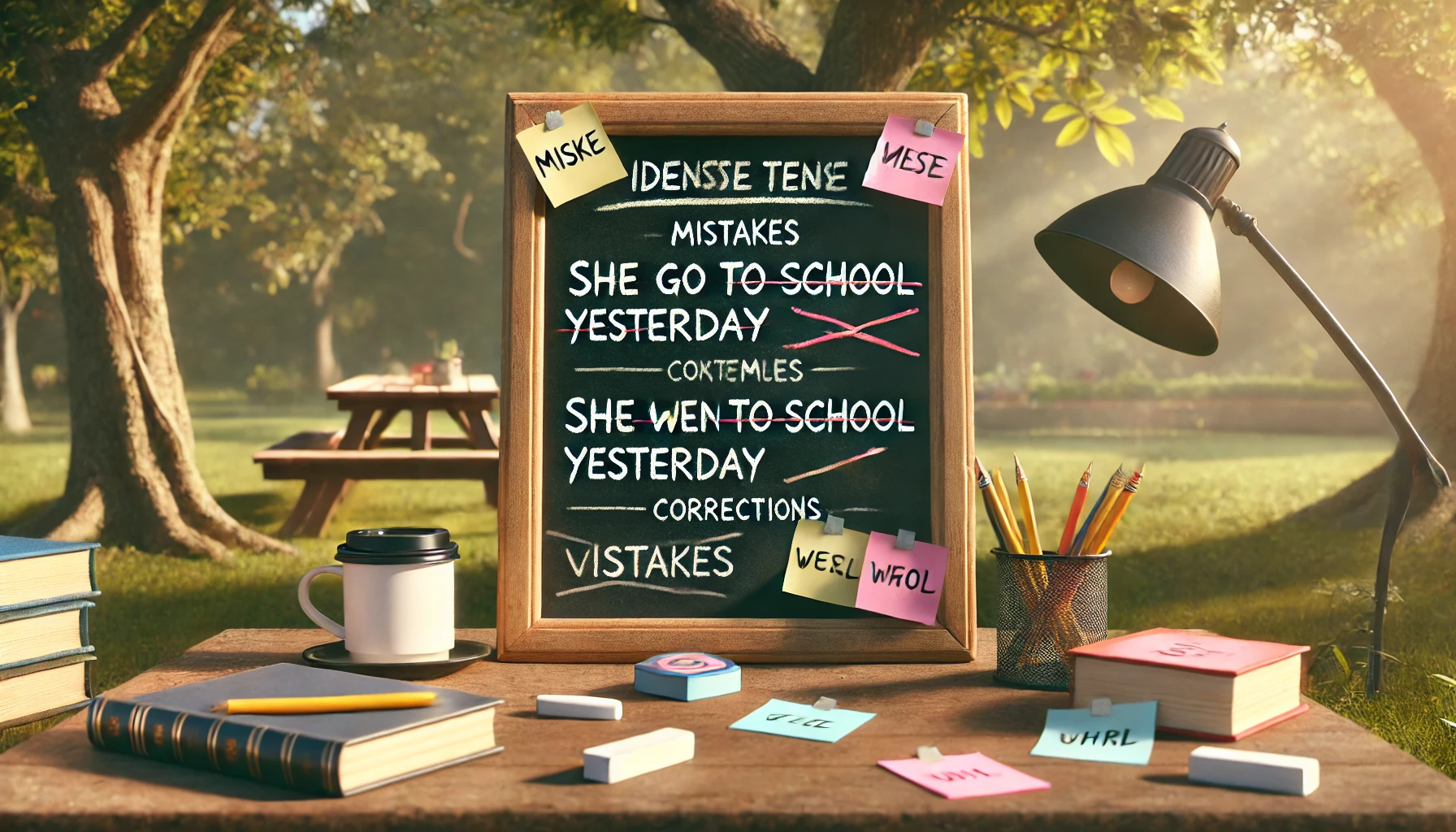Table of Contents
- 1. Introduction
- 2. Misuse of Simple Present Tense
- 3. Confusion Between Past Simple and Past Perfect
- 4. Incorrect Use of Future Tenses
- 5. Switching Tenses Mid-Sentence
- 6. Overusing Present Continuous Tense
- 7. Neglecting Time Markers
- 8. Lack of Subject-Verb Agreement
- 9. Common Errors with Perfect Tenses
- 10. Conclusion
1. Introduction
Mastering tenses is fundamental to effective communication in English. However, even seasoned learners and speakers often make mistakes. Common tense mistakes can hinder understanding and lead to confusion, especially in professional or academic settings.
This article explores frequent errors related to English tenses, provides practical examples, and offers actionable tips to avoid them. By the end of this guide, you’ll have a clearer understanding of tense usage and improved confidence in your language skills.
2. Misuse of Simple Present Tense
The Simple Present tense is often used incorrectly, especially by non-native speakers. It describes habitual actions, universal truths, or scheduled events. Common mistakes include:
1. Using the Simple Present for Ongoing Actions
Incorrect: “She works on her homework now.”
Correct: “She is working on her homework now.”
The Simple Present should not be used to describe actions happening at the moment. Instead, the Present Continuous is appropriate.
2. Omitting the -s in Third-Person Singular
Incorrect: “He walk to school every day.”
Correct: “He walks to school every day.”
Remember, verbs in the Simple Present require an -s or -es ending for third-person singular subjects.
3. Confusion Between Past Simple and Past Perfect
Past Simple and Past Perfect are frequently mixed up, particularly when describing sequences of events. The Past Simple is used for completed actions, while the Past Perfect indicates an action that occurred before another past event.
1. Misplacing the Past Perfect
Incorrect: “By the time she arrived, he left.”
Correct: “By the time she arrived, he had left.”
The Past Perfect is necessary when emphasizing the order of past events.
2. Overusing the Past Perfect
Incorrect: “I had eaten dinner and then I had watched TV.”
Correct: “I ate dinner and then I watched TV.”
Use the Past Perfect only when there’s a need to clarify the sequence of events.
4. Incorrect Use of Future Tenses
Future tenses can be confusing, particularly when deciding between Future Simple and Future Continuous. Errors often arise when predicting events or discussing plans.
1. Using Future Simple for Planned Actions
Incorrect: “I will go to the gym tomorrow at 6 PM.”
Correct: “I am going to the gym tomorrow at 6 PM.”
The Present Continuous is preferred for scheduled or planned actions.
2. Mixing Future Simple and Future Perfect
Incorrect: “By next week, I will finish the report.”
Correct: “By next week, I will have finished the report.”
Use the Future Perfect when emphasizing the completion of an action before a future point.
5. Switching Tenses Mid-Sentence
Maintaining consistent tense usage is crucial for clarity. Switching tenses within a sentence can confuse readers or listeners.
1. Mixing Past and Present Tenses
Incorrect: “He went to the store and buys some milk.”
Correct: “He went to the store and bought some milk.”
2. Mixing Future and Present Tenses
Incorrect: “She will call you when she reaches.”
Correct: “She will call you when she has reached.”
6. Overusing Present Continuous Tense
The Present Continuous tense is often misused or overused, especially by learners who are trying to sound fluent. While this tense is useful for describing ongoing actions, it is not appropriate for every situation.
1. Using Present Continuous for Habitual Actions
Incorrect: “I am going to school every day.”
Correct: “I go to school every day.”
The Simple Present tense is more appropriate for habitual or regular actions.
2. Overusing Present Continuous for Stative Verbs
Incorrect: “I am knowing the answer.”
Correct: “I know the answer.”
Stative verbs, which describe states of being or mental processes, are not usually used in the Present Continuous.
7. Neglecting Time Markers
Time markers are essential for clarifying when an action occurred or will occur. Neglecting these markers can result in unclear or incorrect sentences.
1. Missing Time Markers in Past Tenses
Incorrect: “I finished my homework.”
Correct: “I finished my homework yesterday.”
Adding time markers like “yesterday,” “last week,” or “in 2019” helps specify when the action occurred.
2. Misplacing Time Markers in Future Tenses
Incorrect: “By tomorrow, she will finish the report.”
Correct: “By tomorrow, she will have finished the report.”
Time markers like “by” and “by the time” often require the Future Perfect tense.
8. Lack of Subject-Verb Agreement
Subject-verb agreement errors are common, especially in the Simple Present tense where verb endings vary based on the subject.
1. Third-Person Singular Errors
Incorrect: “She walk to the park.”
Correct: “She walks to the park.”
Always ensure that verbs in the third-person singular form include the correct -s or -es ending.
2. Plural Subject Errors
Incorrect: “The students was happy.”
Correct: “The students were happy.”
Plural subjects require plural verb forms for agreement.
9. Common Errors with Perfect Tenses
Perfect tenses are versatile but prone to errors due to their complex structure. These mistakes often involve misplacing auxiliary verbs or using the wrong time markers.
1. Forgetting the Auxiliary Verb
Incorrect: “She completed the project.”
Correct: “She has completed the project.”
The Present Perfect requires an auxiliary verb like “has” or “have.”
2. Using the Wrong Time Marker
Incorrect: “She has completed the project last week.”
Correct: “She completed the project last week.”
Use the Simple Past tense with time markers like “yesterday” or “last week.”
10. Conclusion
Common tense mistakes can undermine your communication and confuse your audience. By understanding the specific uses of each tense and practicing regularly, you can avoid these errors and express yourself more effectively.
Focus on maintaining tense consistency, matching time markers with the correct tense, and practicing common sentence structures. By doing so, you’ll gain confidence in using tenses correctly, whether in writing or conversation.




